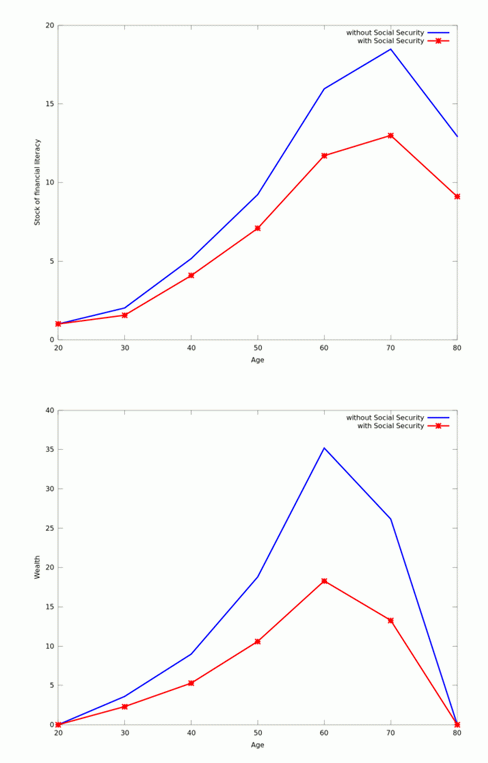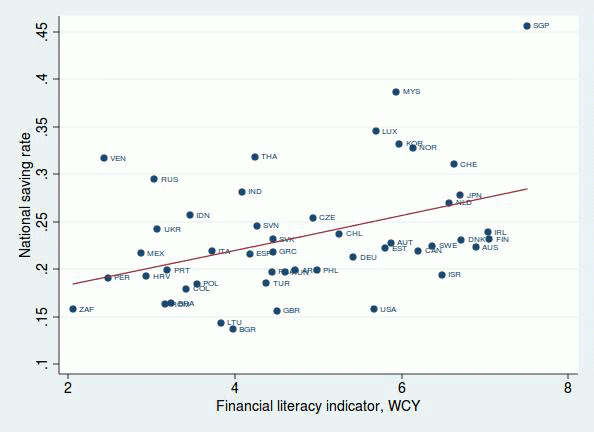The demographic transition is increasingly shifting the responsibility of saving decisions from the welfare system to individuals. The switch from defined benefits to defined contributions pension systems is making individuals more liable for their long-term saving choices. In addition, the recent financial crisis has questioned people’s ability to manage their debts.
Money on the mind
Poor financial decisions are often associated with low levels of financial literacy. For instance, Van Roij et al. (2007) explore the relationship between financial sophistication and wealth, relying on specific measures of financial literacy. Calvet et al. (2009) find that poor financial sophistication is associated with common investment mistakes, such as under-diversification, portfolio inertia, and the tendency to sell winning stocks and hold losing stocks.
Policymakers and regulators are recognising the importance of financial literacy. The OECD has an ongoing project on financial education, and several initiatives to improve financial literacy have been launched around the world. In the US, the regulation authority has built a foundation, the FINRA Investor Education Foundation, to provide Americans with the skills needed to take successful financial decisions. Yet despite this emphasis on the importance of financial education, few papers have been recognising that financial literacy is possibly determined jointly with saving decisions and that factors driving poor decisions are also affecting the level of knowledge of financial matters.
Only two studies explicitly address the joint determination of financial literacy and saving choices. Christiansen et al. (2008) and Behrman et al. (2010) find that the effect of financial literacy on saving is larger when controlling for the double causality between financial literacy and saving. However, the two studies fail to provide the theoretical framework to study the factors shaping the relationship between financial literacy and saving.
In recent research (Jappelli and Padula 2011), we provide a simple model that treats financial literacy as a specific form of human capital, which individuals can accumulate through investing in financial knowledge. This allows us to integrate the investment in financial literacy into a model of saving choices and therefore to highlight the factors driving the relationship between saving and financial literacy. Financial literacy and wealth are determined jointly and are positively correlated over the life-cycle. Furthermore, the existence of a social security system reduces both wealth accumulation and the incentives to invest in financial information (see Figure 1). This should not be taken as suggesting that improved financial literacy causes wealth to increase. Instead, financial literacy and wealth are positively correlated to the extent that the driving forces of both variables (the return and the cost of financial literacy, and the propensity to substitute consumption over time) affect financial literacy and wealth in the same direction. Furthermore, the model suggests that the level of financial literacy before entering the labour market can be used to single out the effect of financial literacy.
Figure 1. Wealth and stock of financial literacy age-profile
We use cross-country aggregate and micro-data from the PISA score in math and a self-assessed mathematical ability measure available in the Survey of Health, Ageing and Retirement in Europe to provide measures of the level of financial literacy before entering the labour market. These indicators are strongly correlated with measures of current financial literacy (see Figure 2). Both aggregate and micro-data confirm the positive association between financial literacy and wealth (and saving, see Figure 3) and suggest that neglecting the joint determination of literacy and saving leads us to understate the effect of literacy on saving choices.
Figure 2. PISA score and the IMD World Competitiveness Yearbook indicator of financial literacy
Figure 3. Financial literacy and national saving
With this in mind, we find that increasing financial literacy by 1 standard deviation is associated with an increase in the national saving rate by 3.6 points; the elasticity of private wealth with respect financial literacy is just below 30%.
Policy implications
The results imply that countries that exhibit higher financial literacy also have higher saving rates, thus indicating a strong link between financial literacy and wealth accumulation, which has two implications for policy.
- First, improving mathematical skills could increase a country’ financial literacy and wealth accumulation.
- Second, financial market reforms associated with financial market deepening (e.g., the creation of private pension funds) by raising the incentive to invest in financial literacy, could lead also to improvements in financial literacy and saving.
Education has many benefits. As our research shows, an unexpected one may be that it improves people’s understanding of finance, bringing with it rewards for themselves and the wider economy.
References
Behrman, Jere R, Olivia S Mitchell, Cindy Soo, and David Bravo (2010), “Financial literacy, schooling, and wealth accumulation”, NBER Working Papers No. 16452.
Calvet , Laurent E, John Y Campbell, and Paolo Sodini (2009), “Measuring the Financial Sophistication of Households”, American Economic Review, 99(2):393-398, May.
Christiansen, Charlotte, Juanna S Joensen, and Jesper Rangvid (2008), “Are economists more likely to hold stocks?”, Review of Finance, 12(3): 465-496.
Jappelli, Tullio and Mario Padula (2011), “Investment in Financial Literacy and Saving Decisions”, CSEF Working Paper No. 272.
Lusardi, Annamaria and Olivia S Mitchell (2007), “Baby boomer retirement security: The roles of planning, financial literacy, and housing wealth”, Journal of Monetary Economics, 54(1):205–224
Lusardi, Annamaria and Olivia S Mitchell (2008), “Planning and financial literacy: How do women fare?”, American Economic Review, 98(2):413-417.
van Rooij, Maarten, Annamaria Lusardi, and Rob Alessie (2007), “Financial literacy and stock market participation”, NBER Working Paper No. 13565.
van Rooij, Maarten, Annamaria Lusardi, and Rob Alessie (2009), “Financial literacy and retirement planning in the Netherlands”, DNB Working Papers 231.





